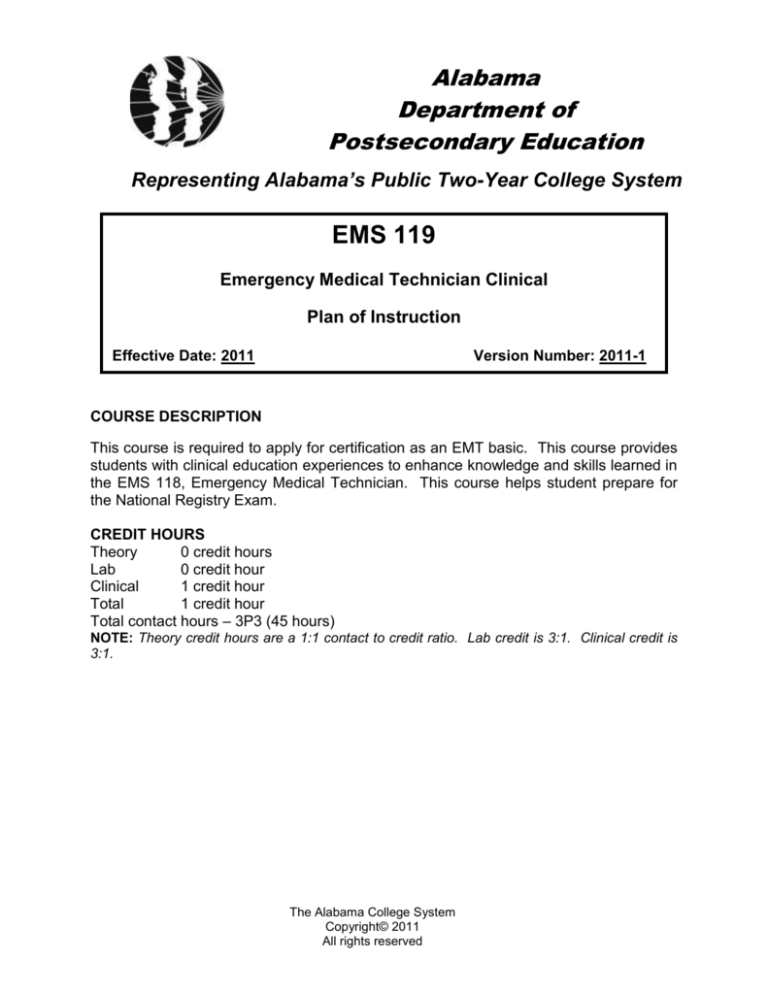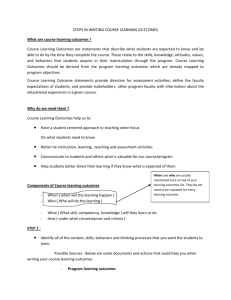
Alabama
Department of
Postsecondary Education
Representing Alabama’s Public Two-Year College System
EMS 119
Emergency Medical Technician Clinical
Plan of Instruction
Effective Date: 2011
Version Number: 2011-1
COURSE DESCRIPTION
This course is required to apply for certification as an EMT basic. This course provides
students with clinical education experiences to enhance knowledge and skills learned in
the EMS 118, Emergency Medical Technician. This course helps student prepare for
the National Registry Exam.
CREDIT HOURS
Theory
0 credit hours
Lab
0 credit hour
Clinical
1 credit hour
Total
1 credit hour
Total contact hours – 3P3 (45 hours)
NOTE: Theory credit hours are a 1:1 contact to credit ratio. Lab credit is 3:1. Clinical credit is
3:1.
The Alabama College System
Copyright© 2011
All rights reserved
EMT Clinical
EMS 119
PREREQUISITE COURSES
Determined by college unless stated otherwise
CO-REQUISITE COURSES
EMS 118 – Emergency Medical Technician
INSTRUCTOR NOTE: Students must satisfy evaluations for both EMS 118 and 119.
The required patient contacts must meet or exceed the requirements from the National
Standard Curriculum. Students must score 75% or higher on the qualifications
exam to qualify to take the National Registry Exam.
PROFESSIONAL COMPETENCIES
The student will function in a supervised clinical setting as an entry-level Basic
Emergency Medical Technician.
The student will be prepared for service, dressed professionally, and will act in a safe
manner.
GENERAL INSTRUCTIONAL GOALS
Cognitive - Comprehend foundational knowledge of the EMT basic.
Performance - Apply foundational knowledge of the EMT basic.
Affective - Develop an appreciation for the necessary level of care to be provided by
an EMT basic.
PROFESSIONAL COMPETENCIES/STUDENT PERFORMANCE
Unless otherwise indicated, evaluation of student’s attainment of cognitive,
psychomotor, and affective objectives is based on knowledge gained from this course.
Competencies specified for each module may be set by: National Standard Curriculum,
certification agencies, national and state codes, health care facility policies, locally
developed lab/clinical assignments, or any combination.
COURSE CONTENT OUTLINE
See EMS 118
COURSE REVIEW AND REGISTRY PREPARATION
Medical terminology review
Airway and breathing
Cardiology
Medical emergencies
Trauma
ACS Copyright© 2011
All rights reserved
2
EMT Clnical
EMS 119
OB/GYN/Peds
Operation procedures
Qualification exam
ACS © 2011
All rights reserved
3
EMT Clnical
EMS 119
Knowledge, Skills, and Attitudes (KSA) Indicators
Performance
Ability
Value
4
Key Word(s)
Highly
Proficient
3
Proficient
2
Affective
Knowledge
Knowledge of
Skills
1
d
c
Partially
Proficient
Limited
Proficiency
Complete
Theory
Operating
Principles
Definition
Performs competency quickly and accurately. Instructs others how to do the
competency.
Performs all parts of the competency. Needs only a spot check of completed
work.
Performs most parts of the competency. Needs help only on hardest parts.
Performs simple parts of the competency. Needs to be told or shown how to
do most of the competency.
Predicts, isolates, and resolves problems about the competency.
Identifies why and when the competency must be done and why each step is
needed.
b
Procedures
Determines step-by-step procedures for doing the competency.
a
Nomenclature
D
Evaluation
C
Analysis
Analyzes facts and principles and draws conclusions about the subject.
B
Principles
Identifies relationship of basic facts and states general principles about the
subject.
A
Facts
*5
Characterization
by Value
*4
Organization
*3
Valuing
*2
Responding
*1
Receiving
Names parts, tools, and simple facts about the competency.
Evaluates conditions and makes proper decisions about the subject.
Identifies basic facts and terms about the subject.
Acting consistently with the new value.
Integrating a new value into one's general set of values, giving it some ranking
among one's general priorities.
Showing some definite involvement or commitment.
Showing some new behaviors as a result of experience.
Being aware of or attending to something in the environment.
Alpha Scale Values - Any item with an upper case letter (A, B, C, D) by itself is taught as general information on a topic. This information may be related to the
competency or encompass multiple competencies. Examples might include mathematical computations or knowledge of principles such as Ohm’s Law.
A lower case letter indicates a level of ”Knowledge of Skills." Individuals are taught information pertaining to performing a competency . These may be indicated
alone or in conjunction with a numerical scale value. A lower case letter by itself indicates the individual is not required to perform the task-just know about the task.
(example: Can state or explain procedures for doing a task).
Numerical Scale Values - The numbers reflect the levels the individual will be able to perform a competency. Number values are always accompanied by lower
case letters (i.e. 1a, 2b, 3c...etc.) in order to specify the level of knowledge of skills associated with the competency.
Example: An individual with a competency with a scale indicator of 3b has received training of knowledge of skills whereby he or she can determine the correct
procedures and perform with limited supervision; only requiring evaluation of the finished product or procedure.
Asterisk items indicate desired affective domain levels and are used to indicate the desired level for a given competency. They may be used independently or with
other indicators (i.e. 1a-*1, 2c-*3). If used with another indicator, separate with a hyphen.
NOTE: Codes indicate terminal values.
ACS © 2011
All rights reserved
4
EMT Clnical
EMS 119
Northeast Alabama Community College
Evaluation of Learning Outcomes for Career/Technical Courses
Student Learning Outcomes Form 1
Faculty regularly review the extent to which the course and program learning outcomes identified in a
course syllabus are being attained by students who complete the course. Each syllabus identifies the
assessment method that will be used to demonstrate student mastery of the desired learning outcomes
for that course. Before teaching a course, faculty should review the syllabus to understand how the
learning outcomes will be evaluated. Once the course is complete, this form is used by the instructor to
report how well students demonstrated mastery of those course learning (and by extension, program
learning) outcomes.
Course Prefix & No.: EMS 119
Instructor:
Semester:
Type of Delivery – Mark One*:
Course Title: Emergency Medical Technician Theory
Date:
Section Number(s):
Dual Enrollment
Online
Traditional
*Double click on the appropriate box. When the form field menu appears, select “checked” under Default value.
Note: To insert or delete rows on the table, click on Table on the tool bar.
Learning Outcome
Evaluation Method
Evaluation Results
(Industry or Professional
Competency)
Explain how each learning outcome for this course is
assessed.
Of the students who earned a grade of C
or better for the course, what percentage
demonstrated attainment of the stated
outcomes?
The student will
function in a
supervised clinical
setting as an entrylevel Basic
Emergency Medical
Technician
The student will be
prepared for
service, dressed
professionally, and
will act in a safe
manner
The student’s ability to function as an
entry-level Basic EMT in the clinical
setting will be evaluated through scoring
a minimum of 750 points out of a
possible 1000 on the “Clinical Evaluation
Form.”
The student’s preparedness,
professional appearance, and safety will
be evaluated through 100% competence
in these areas on the “Clinical Evaluation
Form.”
Use of Evaluation Results
Explain how evaluation results will be used to improve the course.
*Reviewed:
Division Director or Program Supervisor
Date
*To be completed by Division Director or Program Supervisor Only
ACS © 2011
All rights reserved
5








